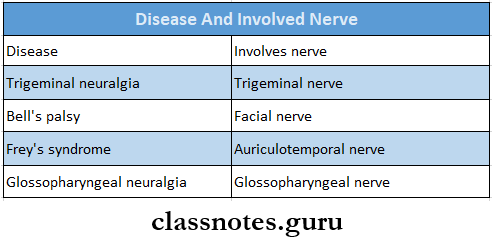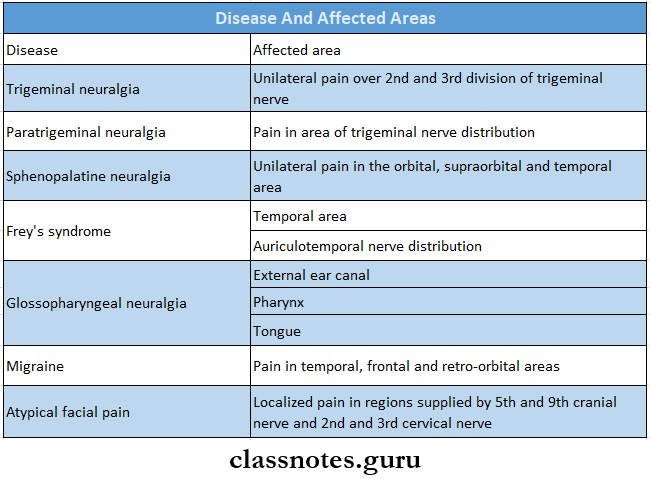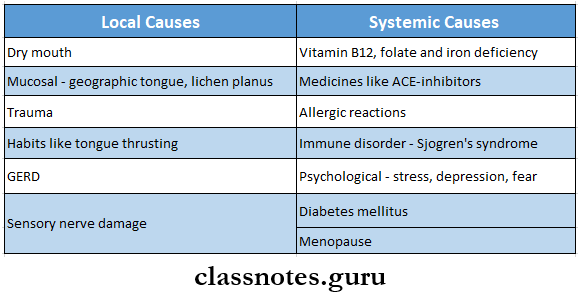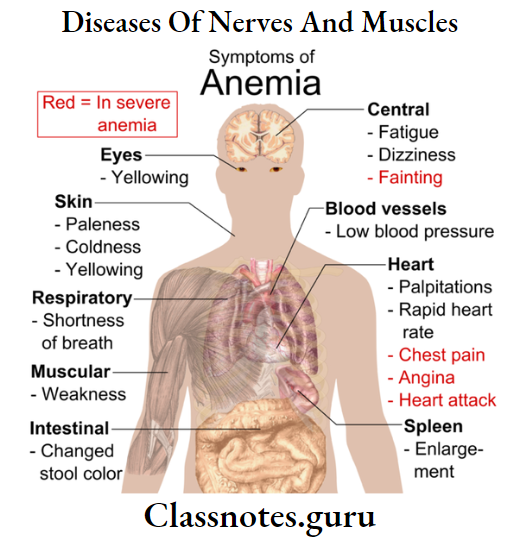Diseases Of Nerves And Muscles Important Notes
1. Disease And Involved Nerve

2. Disease And Affected Areas

3. Causes Of Burning Mouth Syndrome

4. Features Of Eagle’s Syndrome
- Elongation of the styloid process
- Ossification of the stylohyoid ligament
- Dysphagia
- Sore throat
- Otalgia
- Glossodynia
- Headache
- Vague orofacial pain
- Pain along the distribution of internal and external carotid artery
5. Horner’s Syndrome Is Characterized By
- Miosis – contraction of the pupil
- Ptosis – drooping of the eyelid
- Anhidrosis and vasodilatation over face.

Diseases Of Nerves And Muscles Short Question And Answers
Question 1. Mention the different types of neuralgias. Explain in detail about trigeminal neuralgia
Answer:
Types Of Neuralgias:
- Trigeminal neuralgia
- Paratrigeminal neuralgia
- Atypical neuralgia
- Geniculate neuralgia
- Glossopharyngeal neuralgia
- Migrainous neuralgia
- Occipital neuralgia
- Postherpetic facial neuralgia
- Sphenopalatine ganglion neuralgia
- Superior laryngeal neuralgia
- Tympanic plexus neuralgia
Trigeminal Neuralgia: It refers to the pain along the distribution of any branch of the trigeminal nerve
Trigeminal Neuralgia Etiology:
- Idiopathic
- Traumatic compression of the nerve
- Biochemical change in the nerve cells
- Abnormal blood vessels
Read And Learn More: Oral Pathology Questions and Answers
Trigeminal Neuralgia Clinical Features:
- Commonly affects older adults
- Females are more commonly affected
- Causes severe, unilateral, and lancinating types of pain
- Pain lasts for only a few seconds or minutes and then disappears
- Pain occurs on stimulation of trigger zones
- Trigger zones are:
- Vermillion border of lips
- Around eyes
- Ala of nose
- Stimulation of these zones occurs by
- Shaving
- Washing face
- Applying lotion, cosmetics
- Chewing
- Brushing
- Touching
- Strong breeze
- Pain produces spasmodic contractions of facial muscles
- So this is called Tic doulorreux
- This leads to a poor lifestyle
Trigeminal Neuralgia Treatment:
- Peripheral neurectomy
- Injection of alcohol or boiling water into gasserian ganglion
- Injection of steroid or anesthetic agent into the ganglion
- Electrocoagulation
- Administration of carbamazep pine and phenytoin
- Microsurgical decompression of the trigeminal root
Trigeminal Neuralgia Differential Diagnosis:
- Migraine
- Sinusitis
- Tumors of the nasopharynx
- Trotter’s syndrome
- Postherpetic neuralgia
- TMJ disorder
- Intracranial hemorrhage
- Acute pulpitis
Question 2. Bell’s palsy
Answer:
Bell’s palsy
Idiopathic paralysis of the facial nerve of sudden onset
Bell’s palsy Etiology: 5 Hypothesis:
- Rheumatic
- Cold
- Ischaemia
- Immunological
- Viral
Bell’s Palsy Clinical Features:
- Pain in post auricular region
- Sudden onset
- Unilateral loss of function
- Loss of facial expression
- Absence of wrinkles on the forehead
- Inability to close the eye- an effort to do so causes rolling of the eyeball upwards
- Watering of eye
- Inability to blow the cheek
- Nasolabial fold disappears
- The tip of the nose deviates
- Loss of taste sensation
- Hyperacusis
- Slurring of speech
Bell’s Palsy Management:
- Physiotherapy
- Facial exercises
- Massaging
- Electrical stimulation
- Protection to eye
- Covering of eye with a bandage
- Medical Management
- Prednisolone 60-80 mg per day
- 3 tablets for 1st 4 days
- 2 tablets for 2nd 4 days
- 1 tablet for 3rd 4 days
- Surgical Treatment
- Nerve decompression
- Nerve grafting
- Medical Management
Question 3. Myasthenia gravis
Answer:
Myasthenia Gravis
Myasthenia Gravis is an acquired autoimmune disorder characterized clinically by the weakness of skeletal muscles and fatigability on exertion
Myasthenia Gravis Etiology:
- Idiopathic
- Autoimmune- antibodies are produced against acetylcholine receptors of the muscles
Myasthenia Gravis Clinical Features:
- Mainly involves middle-aged women
- Weakness of voluntary muscles
- Muscles of mastication and facial expression are involved
- Difficulty in mastication and deglutition
- Dropping of jaw
- Slow and slurred speech
- Taste alteration
- Diplopia and ptosis
- Weakness of neck muscles
- Loss of weight
- Dry mouth
- Atypical facial pain
- Candidiasis
- Hyperplasia of the thyroid gland
- Death due to respiratory failure
Myasthenia Gravis Treatment: Intramuscular administration of physostigmine
Question 4. Sphenopalatine neuralgia
Answer:
Sphenopalatine Neuralgia
Sphenopalatine Neuralgia is a pain syndrome referable to nasal ganglion
Sphenopalatine Neuralgia Etiology:
- Irritation of nasal ganglion
- Irritation to vidian nerve
Sphenopalatine Neuralgia Clinical Features:
- Males below 40 years of age are commonly affected
- Unilateral intense pain in the region of eyes, maxilla, ear, and mastoid, the base of the nose, beneath the zygoma
- Pain is rapid in onset
- Persists for 15 minutes to several hours
- Absence of trigger zones
- Pain occurs at exactly at same time every day so it is called an alarm clock headache
- Sneezing
- Swelling of the nasal mucosa
- Severe nasal discharge
- Epiphora
- Watering of eyes
- Paraesthesia of skin over the lower half of the face
- Sphenopalatine neuralgia Treatment:
- Alcohol injection into sphenopalatine ganglion
- Use of ergotamine or methysergide
- Surgical correction of septal defects
Question 5. Eagle’s syndrome
Answer:
Eagle’s Synonym: DISH syndrome
Eagle’s Syndrome Types:
- Classic type- occurs after tonsillectomy
- Carotid artery syndrome- Results from calcification of stylohyoid ligament
- Traumatic Eagle’s syndrome- develops after a fracture of the stylohyoid ligament
Eagle’s Syndrome Clinical Features:
- Age- common in adults
- Elongated styloid process
- Pain In the lateral pterygoid area and side of the lower face and neck
- Difficulty In swallowing
- Sore throat
- Glossodynia
- Headache
- Dull lo severe hemiacial pain
- Blurred vision
- Vertigo
Eagle’s Syndrome Radiographic Features:
- Elongation of the styloid process is seen
- Eagle’s Syndrome Management:
- Topical anaesthesia
- Surgical resection or segmentation of elongated styloid process
- Corticosteroid injection
Question 6. Frey’s syndrome
Answer:
Frey’s Syndrome
Frey’s Syndrome is auriculotemporal nerve syndrome
Frey’s Syndrome Causes: Iatrogenic causes followed by parotidectomy
Frey’s Syndrome Features:
- Pain in auriculotemporal nerve distribution
- Gustatory sweating
- Flushing on the affected side
- Frey’s syndrome Diagnosis:
- Positive starch iodine test
Frey’s Syndrome Treatment:
- Topical application of anticholinergic
- Radiation therapy
- Surgical procedures
- Skin excision
- Nerve section
- Tympanic neurectomy
Question 7. Myofunctional pain dysfunction syndrome
Answer:
Myofunctional Pain Dysfunction Syndrome
- Myofunctional Pain Dysfunction Syndrome is a disorder characterized by facial pain limited to mandibular function, muscle tenderness, joint sounds, absence of significant organic and pathologic changes in TMJ
- Myofunctional Pain Dysfunction Syndrome may be due to functional derangement of dental articulation, psychological state of mind, or physiological state of joint
Myofunctional pain dysfunction syndrome Etiology:
- Extrinsic Factors
- Occlusal disharmony
- Trauma
- Environmental factors
- Habits
- Intrinsic Factors
- Internal derangement of TMJ
- Anterior locking of disc
- Trauma
Myofunctional Pain Dysfunction Syndrome Clinical Features:
- Unilateral preauricular pain
- Dull constant
- Muscle tenderness
- Clicking noise
- Altered jaw function
- Absence of radiographic changes
- Absence of tenderness in the external auditory meatus
Myofunctional Pain Dysfunction Syndrome Management:
- Reassurance
- Soft diet
- Occlusal correction
- Isometric exercises
- Heat application
- Diathermy
- Anaesthetic injections
- Steroids
- Drugs
- Aspirin- 0.3-0.6 gm/4 hourly
- Pentazocine- 50 mg- 2-3 times a day
- Diazepam- 2-5 mg for 10 days
- Acupuncture
Question 8. Trigeminal neuralgia (or) Tie douloureux (or) Fotherglll’s disease
Answer:
Trigeminal Neuralgia Synonyms:
- Tic douloureux
- Trifacial neuralgia
- Fothergill’s disease
Trigeminal Neuralgia Clinical Features:
- Commonly affects older adults
- Females are more commonly affected
- Causes severe, unilateral, and lancinating types of pain
- Pain lasts for only a few seconds or minutes and then disappears
- Pain occurs on stimulation of trigger zones
- Trigger Zones Are:
- Vermillion border of lips
- Around eyes
- Ala of nose
- Stimulation Of These Zones Occurs By
- Shaving
- Washing face
- Applying lotion, cosmetics
- Chewing
- Brushing
- Touching
- Strong breeze
- Pain produces spasmodic contractions of facial muscles
- So this is called Tic doulorreux
- This leads to a poor lifestyle
Question 9. Trigger Zones
Answer:
Trigger Zones
- Trigger zones are cutaneous zones located along the distribution of division of nerve
- Trigger Zones are:
- Vermillion border of lips
- Around eyes
- Ala of nose
- Stimulation Of These Zones Occurs By
- Shaving
- Washing face
- Applying lotion, cosmetics
- Chewing
- Brushing
- Touching
- Strong breeze
Trigger Zones Results:
- Pain
- Poor lifestyle
Question 10. Glossopharyngeal neuralgia
Answer:
Glossopharyngeal Neuralgia
Glossopharyngeal Neuralgia refers to the pain occurring through the distribution of the glossopharyngeal nerve
Glossopharyngeal Neuralgia Etiology:
- Abnormal blood vessels pressing on the glossopharyngeal nerve
- Growth at the base of the skull
- Tumor or infection in the mouth
Glossopharyngeal Neuralgia Clinical Features:
- Pain occurs unilaterally on stimulation of trigger zones
- Pain occurs in the ear, pharynx, tonsillar area, and posterior part of the tongue
- Pain lasts for a few seconds to a few minutes
Glossopharyngeal Neuralgia Trigger Zones:
- Posterior oropharynx
- Tonsillar fossa
Glossopharyngeal Neuralgia Triggering Factors:
- Chewing
- Coughing
- Talking
- Swallowing
- Laughing
Question 11. Facial causalgia (or) Atypical facial pain
Answer:
Facial Causalgia
Facial Causalgia constitutes a group of conditions in which there is a vague, deep, poorly localized pain in the regions supplied by the 5th and 9th cranial nerves and 2nd and 3rd cervical nerves
Facial Causalgia Causes:
- Injury to any peripheral or proximal branch of the trigeminal nerve
- Facial trauma
- Nasal skull fracture
- Following extraction of multi-rooted teeth
Facial Causalgia Treatment: Use of tricyclic antidepressants
Question 12. Gustatory sweating
Answer:
Gustatory Sweating
- Gustatory Sweating is sweating occurring on the forehead, face, and neck soon after ingesting food
- Occurs as a result of nerve damage as in Frey’s syndrome
Diseases Of Nerves And Muscles Viva Voce
- Glossodynia – painful tongue
- Glossopyrosis – burning tongue
- Neuritis is inflammation of the nerve
- Causalgia is used to describe severe pain arising after injury or sectioning of peripheral sensory nerve
- Atypical facial pain lacks a trigger zone
- Atypical odontalgia is pain localized only to teeth
- Multiple sclerosis is an idiopathic inflamed demo lining eating disease of CNS
- Myotonia is the failure of muscle relaxation over the face after cessation of voluntary contraction
- Myasthenia gravis is an acquired autoimmune disorder characterized by weakness of skeletal muscle and fatigability of striated muscle on exertion
- Myositis is inflammation of muscle tissue.
